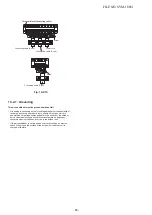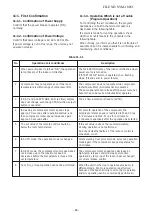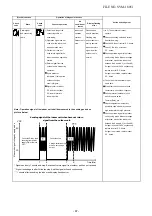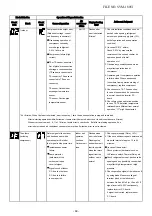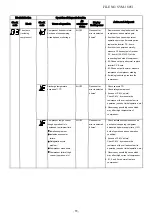
CAUTION
•
KEEP IMPORTANT 6 POINTS FOR
PIPING WORK.
Take away dust and moisture (inside
of the connecting pipes).
Tighten the connections (between
pipes and unit).
Evacuate the air in the connecting
pipes using a VACUUM PUMP.
Check gas leak (connected points).
Be sure to fully open the packed
valves before operation.
Reusable mechanical connectors
and flared joints are not allowed
indoors. When mechanical
connectors are reused indoors,
sealing parts shall be renewed.
When flared joints are reused
indoors, the fl are part shall be
refabricated.
■
Air Purge
From the sake of environmental protection, use a vacuum pump to extract
the air during installation.
* Prepare a 4 mm hexagon wrench.
1. Connect a charge hose.
•
•
Make sure that the Handle Hi of the gauge manifold valve is closed fully.
Connect the port of the gauge manifold valve and the service port (Valve
core (Setting Pin)) using the charge hose.
NOTE
If a control valve or charge valve is attached to the charge hose, leak
of R
32
refrigerant can be avoided.
2. Open the Handle Low of the gauge manifold valve fully, then operate the
vacuum pump.
• Loosen the fl are nut of the at the gas end a little to make sure that air is
taken in, then tighten the nut.
• If you fi nd air is not taken in, make sure that the charge hose is
connected to the port(s) securely.
• Perform extraction for about 15 or more minutes and make sure that the
compound pressure gauge reading is –101 kPa (–76 cmHg).
• If the compound pressure gauge reading is not –101 kPa (–76 cmHg),
there is a possibility air is being taken in from the port(s).
• Make sure that the charge hose is connected to the port(s) securely.
3. Close the Handle Low of the gauge manifold valve fully, then stop
operating the vacuum pump.
• Leave the gauge and pump as they are for 1 or 2 minutes, then make
sure that the compound pressure gauge reading stays at –101 kPa
(–76 cmHg).
• You need not add refrigerant.
4. Disconnect the charge hose from the service port, then open the valve
stem fully using a 4 mm hexagon wrench.
Hexagon wrench is
required.
Service port cap
5. Tighten the service valve stem cap and service port cap securely.
Valve stem cap
CAUTION
Use a torque wrench and tighten the nut at
the specifi ed torque value.
Fig. 10-2-
11
■
Insulation of the Refrigerant Pipes
• Insulate the refrigerant pipes for liquid and gas separately.
Heat-proof bubble polyethylene
Underground piping: 10t
(Laying the pipes on the wall,
ceiling, or under the fl oor)
6. Tighten all the caps on the valves securely, then perform a gas leak
inspection.
• The cap with the 9.52 mm outer diameter is available in two sizes in
accordance with the type of packed valve for which the cap is used.
The tightening torque depends on the width across fl ats of the cap so
check it in the table below.
Service valve
Tighten torque
Valve stem cap
Service port cap
mm
N•m
kgf•m
N•m
kgf•m
Liquid side
(9.52)
H19 mm
14 to 18
1.4 to 1.8
H22 mm
33 to 42
3.3 to 4.2
Gas side (12.7)
33 to 42
3.3 to 4.2
14 to 18
1.4 to 1.8
Pressure gauge
Manifold valve
Handle Hi
(Keep full closed)
Charge hose
Service valve at
the liquid side
Vacuum pump adapter
for counter-
fl ow
prevention
Charge hose
Service port
(Valve core (Setting pin))
Service valve at the gas
side
Compound pressure gauge
–101 kPa (–76 cmHg)
Handle Low
Vacuum pump
-
-
■
Gas Leak Inspection
• Perform a gas leak inspection for the fl are nut connections, valve
stem connection, and service port cap without fail.
• Use a leak detector exclusively manufactured for R
32
.
Flare nut connections (Indoor unit)
Check places for outdoor unit
Fig. 10-2-
12
FILE NO. SVM-18051
- 57 -

















